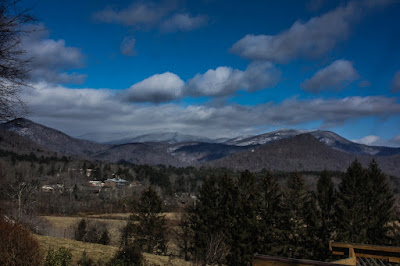Physics Photo of the Week
January 26, 2024
"Rimey" Craggys
A recent cold weather weekend (Jan 19-21, 2024) had temperatures at Warren Wilson College dip into the single digits. January 19 was cloudy and snowy all day although very little accumulation occurred. Clear weather on Saturday, January 20 revealed the Great Craggy Mountains that overlook Warren Wilson College were coated with rime ice from the overnight winter storm.
 The center of the upper photo is enlarged in the photo at right. The distant tops of the Craggy Mountains were coated in the white rime ice that
The center of the upper photo is enlarged in the photo at right. The distant tops of the Craggy Mountains were coated in the white rime ice that
clings to the tree tops. At lower elevations, the tree tops are bare and we see snow deposited on the ground.
Rime ice is an interesting winter formation that we experience in the mountains in winter weather. Rime occurs when clouds exist at below freezing temperatures. In such clouds, the cloud particles are liquid water micro drops that remain liquid. The water droplets are super-cooled. That is they remain liquid below the freezing point. In order for water to freeze, it needs a solid surface - container walls, dust particles, or twigs and branches of trees in order to form ice. Most fog water droplets in sub-freezing are thus super-cooled liquid water below the normal freezing point. When a super-cooled water droplet does come in contact with a solid surface, the solid surface presents a nucleation site, or minor disturbance, that triggers instant freezing of the liquid. When frost forms on a grassy lawn, the frost crystals tend to form on the edges outlining the edges of the grass leaves. Rime ice is very important for aviators to avoid. When an airplane flies through clouds that are below freezing, rime ice can form on the wings and control surfaces of the aircraft and slow down the aircraft and end in a crash. Thus airplane fuselages are often treated with ice-dissolving solutions before taking off into sub-freezing clouds. They also ascend to get above the clouds as soon as possible.
Several years ago (late January 2021) I had the chance to view the results of a rime event on Jones Mountain near Warren Wilson College. There was rime at the top - an easy hike from my house. The picture at left shows some rime-ice crystals that formed on a branch of pine needles near the top of Jones mountain. Notice that the delicate rime-frost crystals all formed on one side of the pine needles and point towards the left side of the photo. I believe that these needle-like crystals are pointing into a light wind coming from the left. This seems counter-intuitive to "normal" physics. We might expect that the frost deposits would collect on the trailing side of the twigs similar to a flag waving off the down-wind side of the flag pole. However, if we realize that the wind is gentle, the water droplets will freeze and bond to the obstacle immediately and build-up the delicate ice crystal facing into the oncoming droplets.
The only way to prove this hypothesis would be to hike out into the freezing fog when the rime is forming - in the middle of the night with lights and gear to make photos or videos of the ice forming and noticing the actual direction of the wind. Not a pleasant thought.
======================================================================
Physics Photo of the Week is published periodically during the academic year on Fridays by Donald F. Collins, professor emeritus of Warren Wilson College. These photos feature interesting phenomena in the world around us. Students, faculty, and others are invited to submit digital (or film) photographs for publication and explanation. Atmospheric phenomena are especially welcome. Please send any photos to dcollins@warren-wilson.edu.
All photos and discussions are copyright by Donald Collins or by the person credited for the photo and/or discussion. These photos and discussions may be used for private individual use or educational use. Any commercial use without written permission of the photoprovider is forbidden.





Comments
Post a Comment